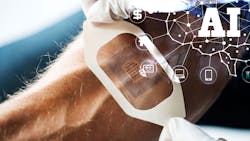Integrating AI into Medical Devices and Applications
New AI advances in hardware and software have allowed engineers and scientists to interpret physiological data from sensors—a once challenging, if not impossible, feat. With these advances comes the rapid growth of FDA-approved wearables like smart watches, which contain digital health-monitoring applications and provide engineers with data and tools to process their signals. This trend in the growing number of wearables entering the market impacts engineers as more companies look to integrate their products and services with artificial-intelligence-based applications, especially in the digital health monitoring segment.
Senior Technology Editor Bill Wong talks with Arvind Ananthan, Medical Devices Industry Manager at MathWorks, about the significant expansion of the wearables market, and how medical device and digital health application design teams can incorporate AI-driven digital health applications into their companies’ products. Also discussed are the challenges associated with the product design process.
What factors have contributed to the growth of the wearables and digital health applications markets?
Until recently, interpreting physiological data in an automated manner from sensors was challenging, if not often impossible. AI advances in hardware and software are now enabling engineers and scientists to develop algorithms for automated processing and analyze physiological signals. Both hardware and software developments have been driving this trend.
For hardware, medical sensor technology continues to rapidly advance and enable compact, cost-effective physiological sensors to make their way into off-the-shelf consumer wearable devices. When looking at software, one driver is the availability of AI algorithms that can extract and interpret meaningful information from vast troves of data. This includes noisy data and not-so-perfect signals (such as cardiovascular data from a smart watch) corrupted with various outliers or interference that’s hard to process using traditional algorithms.
What steps can engineers and scientists take to meet the demands of their companies to integrate AI and digital health applications into more products?
Integrating AI and developing machine-learning algorithms consists of two primary steps: feature engineering and classification. Feature engineering identifies features from a data set to be extracted for classification. In the example of cardiovascular data, features would include Normal, Atrial Fibrillation, Other Rhythm, and Too Noisy to classify a patient’s ECG signal. In the second step, the extracted features are fed into a well-known statistical classification algorithm, such as a support vector machine or a traditional neural network, to develop a trained model that can then be used on a new data set for prediction. Once this model is trained using a well-represented labeled dataset until a satisfactory accuracy is achieved, it can then be used on a new dataset to predict cardiovascular signals.
What are potential challenges design teams should look to avoid when developing their AI algorithms?
The feature engineering step is perhaps the hardest part in developing a robust algorithm. It can’t be treated as solely a “data science” problem, as it is important to have the biomedical engineering domain knowledge to understand the different types of physiological signals and data. Tools such as MATLAB bring advanced data analytics and AI capabilities to the domain experts and enable them to focus on feature engineering by making it easier to apply “data science” capabilities.
For those new to AI, determining the right classification model can also be challenging. Classifiers include decision trees, random forests, support vector machines, and K-nearest neighbors (KNN). Again, engineering-workflow-focused tools like MATLAB enable domain experts to test different classification models to determine which is most accurate with minimal coding. Traditionally, spending time on feature engineering and classifier tuning leads to significant further improvement in classification accuracy.
Regulation is a potential non-engineering challenge for design teams who are working in a fluid environment with evolving standards. The FDA is starting to actively simplify regulations to invigorate innovation in the industry through programs such as the Digital Health Software Precertification Program and modeling and simulation in device development.
Arvind Ananthan is the Global Medical Devices Industry Manager at MathWorks. He works closely with medical device engineers, academic researchers in this community, and regulatory authorities including the FDA to understand and address the challenges and needs of this industry covering areas of modeling, simulation, and data analytics. He has over 15 years of experience in a variety of technical and business roles.
About the Author
William G. Wong
Senior Content Director - Electronic Design and Microwaves & RF
I am Editor of Electronic Design focusing on embedded, software, and systems. As Senior Content Director, I also manage Microwaves & RF and I work with a great team of editors to provide engineers, programmers, developers and technical managers with interesting and useful articles and videos on a regular basis. Check out our free newsletters to see the latest content.
You can send press releases for new products for possible coverage on the website. I am also interested in receiving contributed articles for publishing on our website. Use our template and send to me along with a signed release form.
Check out my blog, AltEmbedded on Electronic Design, as well as his latest articles on this site that are listed below.
You can visit my social media via these links:
- AltEmbedded on Electronic Design
- Bill Wong on Facebook
- @AltEmbedded on Twitter
- Bill Wong on LinkedIn
I earned a Bachelor of Electrical Engineering at the Georgia Institute of Technology and a Masters in Computer Science from Rutgers University. I still do a bit of programming using everything from C and C++ to Rust and Ada/SPARK. I do a bit of PHP programming for Drupal websites. I have posted a few Drupal modules.
I still get a hand on software and electronic hardware. Some of this can be found on our Kit Close-Up video series. You can also see me on many of our TechXchange Talk videos. I am interested in a range of projects from robotics to artificial intelligence.


